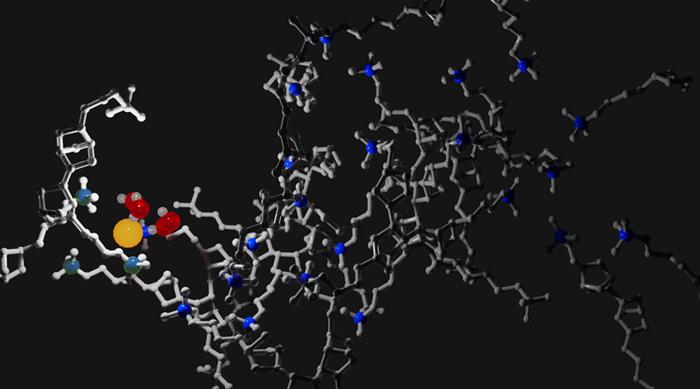Researchers at the University of Chicago Pritzker School of Molecular Engineering (UChicago PME) have fundamentally changed our understanding of anion exchange membranes (AEMs) and their critical role in the increasing efficiency of clean energy technology. Traditional beliefs in the scientific community have long held that high levels of free-flowing water are essential for the effective transport of charged ions across these membranes – pivotal components in devices like fuel cells and redox flow batteries. However, this groundbreaking study, recently published in Nature Communications, reveals an alternative mechanism that could significantly advance the capabilities and applications of AEMs.
The crux of the new research lies in the assertion that achieving swift ion transport does not inherently require an abundance of free water. Instead, the research team discovered that the structure and organization of water molecules within the membrane are more critical. This nuanced understanding allows AEMs to be optimized with only the minimum necessary water to facilitate the establishment of interconnected networks of water that can effectively transport ions.
At the molecular level, researchers detail how anion exchange membranes operate. Embedded within these membranes are specially designed positively charged molecules that excel at attracting and guiding negatively charged ions—referred to as anions—while simultaneously repelling cations, which are positively charged ions. AEMs serve a vital function in various electrochemical devices, helping facilitate reactions that convert chemical energy into electrical energy—a necessity for sustainable and clean energy technology development.
Historically, engineers developing AEMs were inclined toward maintaining higher water levels than perhaps necessary. This approach, however, has limitations, especially in low-humidity environments where excessive free water can lead to structural degradation. In essence, the findings suggest that the ideal balance of water within AEMs lies not in having an excess but rather in optimizing the quantity to maintain a well-structured network conducive to ion transport.
Utilizing advanced computer modeling and experimental data, researchers conducted an in-depth study to observe the interactions between water and ions within AEMs. The use of sophisticated two-dimensional infrared spectroscopy (2D IR) has allowed scientists to visualize and capture the fast dynamics of water molecules on a molecular scale. This state-of-the-art methodology enabled them to observe how water molecules organize within these systems over incredibly short timescales, offering unprecedented insights into their behavior.
Through extensive simulations paired with experimental observations, the research unveiled a previously unrecognized phenomenon—the significance of hydrogen bonding networks formed by water molecules within the membrane. It was discovered that the efficiency of ionic conductivity hinges on the structural arrangement of these hydrogen bonds. With optimal water levels, alongside a strategically organized network of water, ions can travel through AEMs effectively, signaling a shift away from the previously accepted notion requiring abundant free water.
Further analysis revealed that even with reduced water content, the conductive capabilities of AEMs do not diminish, showcasing that well-structured networks of hydrogen bonds effectively facilitate ion transport. In fact, the study documented that as the level of water within the membrane increased, so too did the efficiency of ion movement, driven primarily by improved organization of the water molecules. This indicates a paradigm shift in how we view the operational necessities of anion exchange membranes, paving the way for the design of more efficient energy systems.
This pivotal study marks a significant advancement in the quest for sustainable energy storage technologies, suggesting that scientists can develop membranes capable of operating effectively under low-humidity conditions. The implications are profound for the future of clean energy solutions, as AEMs that are more resilient and efficient could drastically enhance the performance of energy storage systems while reducing dependency on environmental conditions.
The research also underscores a broader opportunity for scientific inquiry; the integrated approach combining experimental techniques with molecular modeling lays a versatile framework that can be applied to various challenges in the study of molecular behavior. A better understanding of the interactions taking place within materials at the molecular level not only facilitates advancements in energy technologies but could also herald innovations across many scientific disciplines, from biochemistry to materials science.
As the scientific community grapples with the implications of these pioneering discoveries, it could prove transformational for a variety of applications reliant on ion-exchange systems. The collective insights gathered throughout this research have vast potential to reshape the landscape of energy technology, driving the performance of systems that rely on AEMs while promoting greater sustainability.
Investments in research supporting these advancements emphasize the importance of continued inquiry into detailed molecular dynamics. With funding from the Department of Energy’s Office of Basic Energy Sciences, the research team is poised to explore further the implications of their findings, potentially opening new avenues for innovation in energy solutions.
The time is ripe for moving forward with this knowledge, propelling the development of next-generation technologies capable of addressing the pressing needs for sustainable and clean energy resources. As researchers refine these findings, the outlook for enhanced energy systems grounded in more durable materials offers a hopeful glimpse into our energy-sustainable future.
Subject of Research: Anion exchange membranes (AEMs)
Article Title: Water-mediated ion transport in an anion exchange membrane
News Publication Date: January 28, 2025
Web References: Nature Communications
References: DOI: 10.1038/s41467-024-55621-z
Image Credits: Credit: UChicago Pritzker School of Molecular Engineering
Keywords
Anion exchange membranes, ion transport, water structure, clean energy technology, molecular dynamics, hydrogen bonding networks, energy efficiency, sustainable materials, electrochemical devices.
Tags: alternative mechanisms in AEMsanion exchange membranescharged ion transportclean energy technologyfuel cell efficiencyion transport mechanismsmembrane optimization techniquesmolecular engineering researchNature Communications publicationredox flow batteriesUniversity of Chicago researchwater organization in membranes





